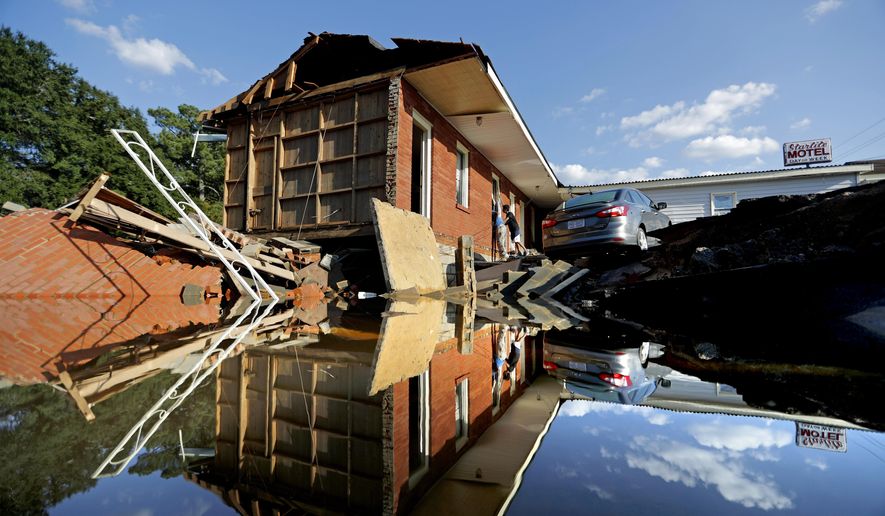WILMINGTON, N.C. (AP) - As rivers swollen to record levels started to recede Thursday in North Carolina, officials tried to head off potential environmental disasters and prepared for more record flooding downstream in South Carolina.
Roads were still clogged with people trying to make it back to where the floods had creeped back, leaving silty mud on walls and floors. Crews closed some bridges and reopened others as trillions of gallons of water continued its long, meandering journey to the Atlantic Ocean.
Potential environmental problems remained. Duke Energy issued a high-level emergency alert after floodwaters from the Cape Fear River overtopped an earthen dike and inundated a large lake at a closed power plant near Wilmington, North Carolina. The utility said it did not think any coal ash was at risk.
State-owned utility Santee Cooper in South Carolina is placing an inflatable dam around a coal ash pond near Conway, saying the extra 2.5 feet (76 centimeters) should be enough to keep floodwaters out. Officials warned human, hog and other animal waste were mixing in with floodwaters in the Carolinas.
South Carolina Gov. Henry McMaster estimated damage from the flood in his state at $1.2 billion in a letter that says the flooding will be the worst disaster in the state’s modern history. McMaster asked Congressional leaders to hurry federal aid.
North Carolina Gov. Roy Cooper said he knows the damage in his state will add up to billions of dollars, but said with the effects on the storm ongoing, there was no way to make a more accurate estimate.
Florence is blamed for at least 41 deaths in North Carolina, South Carolina and Virginia. Well over half of those killed were in vehicles.
In North Carolina, a familiar story was unfolding as many places that flooded in Hurricane Matthew in 2016 were once again inundated.
Pastor Floyd Benfield walked inside his Presbyterian Church of the Covenant in Spring Lake now that the Little River has retreated.
Two years ago, flooding ruined the baseboards and carpet. This year, the water broke the windows, leaving the pews a jumbled mess and soaked Bibles and hymn books on the floor.
“This sanctuary was built in 1909, and it never flooded until Hurricane Matthew,” Benfield said.
In Wilmington, things kept creeping back closer to normal in the state’s largest coastal city. Officials announced the end of a curfew and the resumption of regular trash pickup.
But they said access to the city of 120,000 was still limited and asked people who evacuated to wait a few more days. They also warned people to not get caught off guard as rivers that briefly receded were periodically rising back.
The storm continues to severely hamper travel. Parts of the main north-south route on the East coast, Interstate 95, and the main road to Wilmington, Interstate 40, remain flooded and will likely be closed at least until nearly the end of September, North Carolina Department of Transportation Secretary Jim Trogdon said.
More than a thousand other roads from major highways to neighborhood lanes are closed in the Carolinas, officials said. Some of them have been washed out entirely.
In South Carolina, the flood was far from over. The water appeared to stop rising in Nichols, but the town of 360 was almost entirely submerged for the second time in three years.
Jodi Pajaro owned one of the few houses in Nichols that wasn’t flooded in 2016 by the Little Pee Dee and the Lumber Rivers which flow past either side of the town.
She evacuated like the rest of the residents and tenses up each time her cellphone dings. It is frequently pictures from friends who are rescuers riding boats in town. In the last one she saw, the water was maybe an inch or two (2.5 to 5 centimeters) from her front door.
“It doesn’t look good. I am heartbroken,” she wrote in a text.
The flood has been giving so much warning to Horry County, South Carolina, that officials published a detailed map of places that flooded in 2016 and warned those same places were going underwater again.
One man had time to build a 6-foot (1.8-meter) high dirt berm around his house. Rental trucks and flatbeds whisked furniture and valuables out of homes that were still dry in Conway.
The Waccamaw River has started its slow rise in the city of 23,000, and forecasters expect it to swell more than 3 feet (0.90 meters) above the previous record crest by Tuesday while still rising. Some areas could stay underwater for weeks, forecasters warned.
All that water from Nichols and Conway is heading toward Georgetown County, where five different rivers dump into the Atlantic Ocean. Officials warned more than 10 percent of the county’s 61,000 residents might have to evacuate sometime next week, but called that a worst-case scenario and they couldn’t give any specific forecast.
Authorities planned to start handing out 15,000 sandbags Friday.
“We’re at the end of the line of all waters to come down,” said Georgetown County Administrator Sel Hemingway, as he warned the area may see a flood like it has never seen before.
___
Derosier reported from Spring Lake. Associated Press writers Jonathan Drew, Martha Waggoner and Gary D. Robertson in Raleigh; Jeffrey Collins and Meg Kinnard in Columbia, South Carolina; Michael Biesecker in Washington and Jay Reeves in Atlanta contributed to this report.
___
For the latest on Hurricane Florence, visit https://www.apnews.com/tag/Hurricanes




Please read our comment policy before commenting.